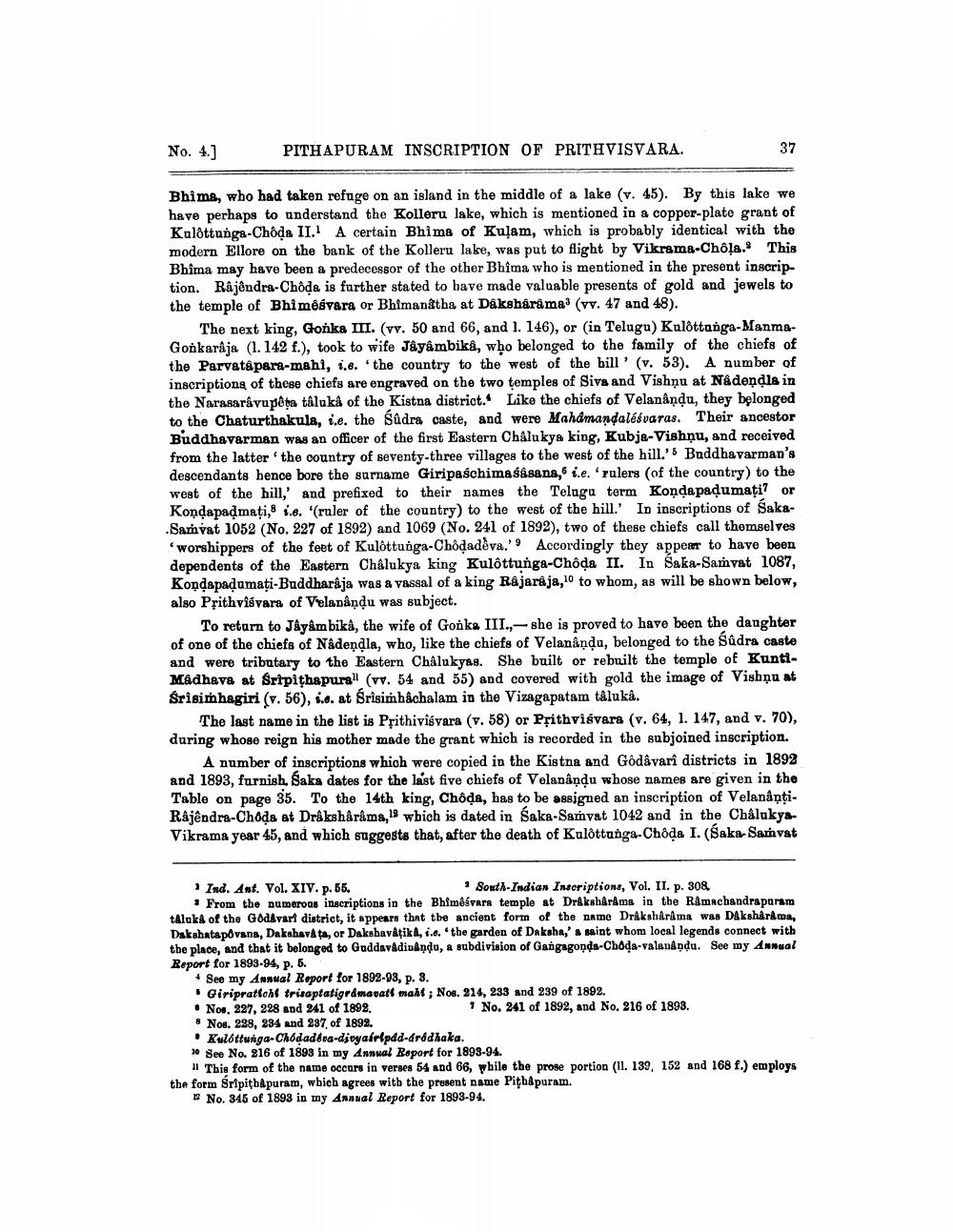________________
No. 4.]
PITHAPURAM INSCRIPTION OF PRITHVISVARA.
Bhims, who had taken refuge on an island in the middle of a lake (v. 45). By this lake we have perhaps to understand the Kolleru lake, which is mentioned in a copper-plate grant of Kulôttunga-Chôda II. A certain Bhima of Kulam, which is probably identical with the modern Ellore on the bank of the Kolleru lake, was put to flight by Vikrama-Chôļ8. This Bhima may have been a predecessor of the other Bhima who is mentioned in the present inscription. Râjândra-Choda is further stated to bave made valuable presents of gold and jewels to the temple of Bhimêsvara or Bhimanátha at Dakshård ma' (vv. 47 and 48).
The next king, Gonka III. (vv. 50 and 66, and 1. 146), or in Telugu) Kulôttanga-ManmaGonkaraja (1.142 f.), took to wife Jâyâmbika, who belonged to the family of the chiefs of the Parvatâpara-mahi, i.e. the country to the west of the bill' (v. 53). A number of inscriptions of those chiefs are engraved on the two temples of Siva and Vishnu at Nådendla in the Narasarávupêta tâlukå of the Kistna district. Like the chiefs of Velanându, they belonged to the Chaturthakula, i.e. the Sudra caste, and were Mahamandalesvaras. Their ancestor Buddhavarman was an officer of the first Eastern Châlukya king, Kubja-Vishņu, and received from the latter the country of seventy-three villages to the west of the hill.'s Buddhavarman's descendants hence bore the surname Giripaschimaśâsana, i.e.rulers (of the country) to the west of the hill,' and prefixed to their names the Telugu term Kondapaļumati? or Kondapadmati, 1.6. '(ruler of the country) to the west of the hill. In inscriptions of SakaSamvat 1052 (No. 227 of 1892) and 1069 (No. 241 of 1892), two of these chiefs call themselves 'worshippers of the feet of Kulôttunga-Chôdadeva.'' Accordingly they appear to have been dependents of the Eastern Chalukya king Kulôttunga-Chôda II. In Saka-Samvat 1087, Kondapadumati-Buddharaja was & vassal of a king Rajaraja, to whom, as will be shown below, also Prithvisvara of Velanåndu was subject.
To return to Jây&mbika, the wife of Gorka III.,- she is proved to have been the daughter of one of the chiefs of Nådendla, who, like the chiefs of Velananda, belonged to the Sûdra caste and were tributary to the Eastern Chalukyas. She built or rebuilt the temple of KuntiMadhava at Sripithapura (vv. 54 and 55) and covered with gold the image of Visbņu at Śrisimhagiri (v. 56), s... at Brisimhachalam in the Vizagapatam tâluka.
The last name in the list is Prithiviśvara (v. 58) or Prithvisvara (v. 64, 1. 147, and v. 70), during whose reign his mother made the grant which is recorded in the subjoined inscription.
A number of inscriptions which were copied in the Kistna and Godavari districts in 1892 and 1893, furnish. Saka dates for the last five chiefs of Velanându whose names are given in the Table on page 35. To the 14th king, Chôda, has to be assigned an inscription of VelanâņtiRajendra-Chods at Drakshârâms, which is dated in Saka-Samvat 1042 and in the ChalukyaVikrama year 45, and which suggests that, after the death of Kulottunga-Chôda I. (Saka Samvat
Ind. Ant. Vol. XIV. p. 55.
South Indian Inscriptions, Vol. II. p. 308 . From the numerous inscriptions in the Bhimêsvara temple at Dråkshåråms in the Ramachandrapuram talaka of the Godavari district, it appears that the ancient form of the name Dråkshårâma was Dakshårdma, Dakshatapovana, Dakabavkta, or Daksbavatika, i.. the garden of Daksha,' saint whom local legends connect with the place, and that it belonged to GuddavAdivando, a subdivision of Gangagonda-Choda-valanându. See my Annual Report for 1893-94, p. 5.
See my Annual Report for 1892-93, p. 3.
Giripratichi trisaptatigramavati maht ; Nos. 214, 233 and 239 of 1892. • Nos, 227, 228 and 241 of 1892.
1 No. 241 of 1892, and No. 216 of 1893. * Nos. 228, 234 and 237 of 1892. • Kulottunga-Chodadera-djoyairlpdd-dredhaka. 10 See No. 216 of 1893 in my Annual Report for 1893-94.
!This form of the name occurs in verses 54 and 66, while the prose portion (11. 139, 152 and 168 f.) employs the form Sripithapuram, wbich agrees with the present name Pithapuram.
No. 345 of 1893 in my Annual Report for 1893-94.




